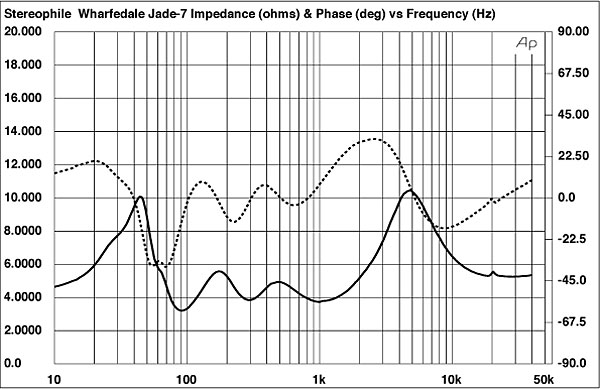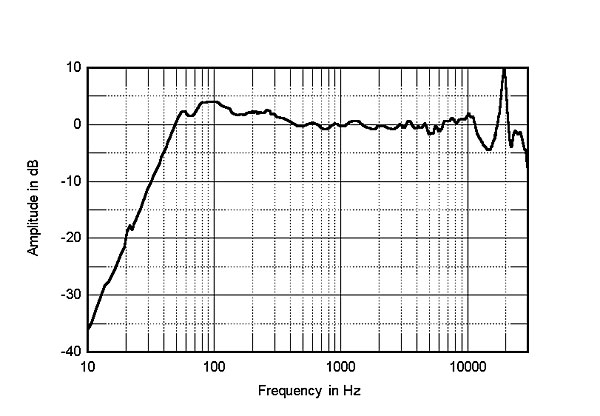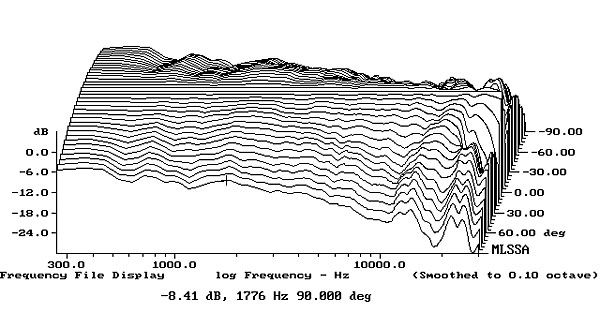| Columns Retired Columns & Blogs |
My guess would be they produce better loudspeakers because they had much better LP's for many years.
I used DRA Labs' MLSSA system and a calibrated DPA 4006 microphone to measure the Wharfedale Jade 7's frequency response in the farfield, and an Earthworks QTC-40 for the nearfield responses. My estimate of the Wharfedale's voltage sensitivity was 87.7dB(B)/2.83V/m, which is within experimental error of the specified 88dB. The speaker's nominal impedance is specified as 6 ohms; the solid trace in fig.1 shows that the impedance magnitude remains between 4 and 6 ohms for much of the audioband, with a minimum of 3.2 ohms at 91Hz. The electrical phase angle (dotted trace) is generally low, however, meaning that a good 4 ohm–rated amplifier or receiver will have no difficulty driving the Jade 7.

The small discontinuity at 20kHz in the impedance traces suggests that this is the tweeter's fundamental dome resonance (ie, where the center of the dome is moving in antiphase to the outer ring)—a lower frequency than normal for a modern metal-dome tweeter. The traces in fig.1 are free from the wrinkles in the midrange that would hint at the existence of enclosure panel resonances of some kind. However, investigating the behavior of the gracefully curved cabinet with a simple plastic-tape accelerometer did uncover several resonant modes, the highest in level lying at 246, 438, and 750Hz (fig.2). This graph was taken with the accelerometer in the center of a sidewall level with the bottom woofer. The mode at 438Hz was the only one that could be detected at other positions on the sidewall. As Robert Deutsch heard no colorations that could have been laid at the feet of resonances in what he described as "an enclosure that is, to a large extent, sonically inert," this behavior looks worse than it sounds.

The single impedance peak centered on 45Hz in fig.1 suggests that Wharfedale's aperiodic woofer alignment is closer to that of a sealed box than a reflex enclosure of some kind. Certainly I could find no appreciable acoustic output coming from the slot between the cabinet proper and the plinth. The blue trace in fig.3 shows the output of the dual woofers; it peaks broadly between 60 and 120Hz, with a second-order high-pass rolloff and closer to a third-order low-pass rolloff. The crossover to the lower-midrange drive-unit (red trace) appears to occur just below 200Hz, as specified, and this driver's output actually overlaps that of the woofers to some extent before rolling off below 600Hz. There is also a broad overlap between the lower-midrange driver's output and that of the small upper-midrange driver (green trace below 3kHz) at the other end of its passband. The tweeter's on-axis response (green trace above 3kHz) rises slightly before ducking in the region below the tweeter's dome resonance, which occurs, as I suspected from the impedance plot, just below 20kHz.

Fig.4 shows how these individual outputs sum in the farfield, averaged across a 30° horizontal window centered on the tweeter axis. Other than the boost of 4dB in the upper bass, which will be an artifact of the nearfield technique used to measure the response in this region, the Jade 7's response is extraordinarily flat! For listeners older than 40 or so, that tweeter resonance will be moot. But I do know a couple of younger listeners whose hearing sensitivity extends up to 20kHz, and it would be a problem for them. In the bass, the speaker gives full output to 50Hz and, with its gentle rolloff, will offer useful extension to 30Hz with the usual boundary reinforcement, as RD found in his listening.

Bob also remarked on the Jade 7's excellent stereo imaging, which tends to be associated with lateral off-axis behavior that is smooth and even. Fig.5 reveals that this is indeed the case with the Jade 7. Each drive-unit's radiation pattern smoothly blends with those of the others to give textbook dispersion. This graph also shows that the on-axis trough in the top octave fills in to the speaker's sides. In the vertical plane (fig.6), the Wharfedale's dispersion, normalized to the response on the tweeter axis, is wide and even—just as well, given that the tweeter is a high 45" above the floor.


In the time domain, the Jade 7's step response on the tweeter axis (fig.7) suggests that the tweeter, the upper-midrange driver, and the woofers are connected in positive acoustic polarity, and the lower-midrange driver in negative polarity; this is confirmed by looking at their individual step responses (not shown). In conjunction with the phase shift from the crossover filters and the differing physical depths of the drive-units' acoustic centers, this allows the decay of each driver's step to smoothly blend with the start of the step next lower in frequency. This correlates with the excellent frequency-domain integration of their outputs seen in fig.3. Finally, other than a ridge of delayed energy at the tweeter's dome resonance frequency of 19.3kHz, the Jade 7's cumulative spectral-decay plot on the tweeter axis (fig.8) is superbly clean.


It is rare to find even an expensive speaker that measures as well as this. That Wharfedale's Jade 7 does so at a price of a dollar less than $4200/pair is especially commendable. I am not surprised RD liked this speaker as much he did.—John Atkinson

My guess would be they produce better loudspeakers because they had much better LP's for many years.

It looks like Wharfedale has tackled some of the stickiest problems in loudspeaker design. The frequency domain summing is excellent, especially the vertical pattern - although I would like to see more angles shown and less averaging. The horizontal pattern is tilted down but is remarkably free of dicontinuities that plague typical 2 and 3 way divisions due to optimized transitions in driver diameter to wavelength ratio.
The 4 way system also reduces spectral contamination from Doppler distortion and the Faraday rings speak to low harmonic and intermodulation distortion. The aperiodic design is apparent from the shown curves, but the degree of benefit is more apparent in group delay or sine burst response graphs. True aperiodicity is achieved by a backwave absorber like the Nautilus, but takes a lot more space for this size of woofer than the acoustic resistance damping.
The negatives are the polarity of the lower midrange and the awful tweeter resonance. My ears don't hear 20KHz directly, but the time distortion of this energy storage and the gross spatial distortion of the off-axis response on the top octave have affect. Also, even burglar alarms at 40KHz penetrate my skull and register on my fight or flight response so I imagine I would find this as annoying as all metal domes. This may be playing to the British brightness bias. Their recordings tend to be trebly and their rooms tend towards over-stuffed which would help.